ASFV-G-∆I177L as an Effective Oral Nasal Vaccine against the Eurasia Strain of Africa Swine Fever
- PMID: 33925435
- PMCID: PMC8146859
- DOI: 10.3390/v13050765
ASFV-G-∆I177L as an Effective Oral Nasal Vaccine against the Eurasia Strain of Africa Swine Fever
Abstract
The African swine fever virus (ASFV) is currently causing a pandemic affecting wild and domestic swine from Western Europe to Asia. No commercial vaccines are available to prevent African swine fever (ASF), resulting in overwhelming economic losses to the swine industry. We recently developed a recombinant vaccine candidate, ASFVG-ΔI177L, by deleting the I177L gene from the genome of the highly virulent ASFV strain Georgia (ASFV-G). ASFV-G-ΔI177L has been proven safe and highly efficacious in challenge studies using parental ASFV-G. Here, we present data demonstrating that ASFV-G-ΔI177L can be administered by the oronasal (ON) route to achieve a similar efficacy to that of intramuscular (IM) administration. Animals receiving ON ASFV-G-ΔI177L were completely protected against virulent ASFV-G challenge. As previously described, similar results were obtained when ASFV-G-ΔI177L was given intramuscularly. Interestingly, viremias induced in animals inoculated oronasally were lower than those measured in IM-inoculated animals. ASFV-specific antibody responses, mediated by IgG1, IgG2 and IgM, do not differ in animals inoculated by the ON route from that had IM inoculations. Therefore, the ASFV-G-ΔI177L vaccine candidate can be administered oronasally, a critical attribute for potential vaccination of wild swine populations.
Keywords: ASF; ASFV; African swine fever; African swine fever virus; I177L; swine; vaccine.
Conflict of interest statement
The authors Douglas Gladue and Manuel Borca have a patent filed for ASFV-G-ΔI177L as an effective vaccine against ASF. No other authors have a conflict of interest.
Figures




References
-
- Lewis T., Zsak L., Burrage T.G., Lu Z., Kutish G.F., Neilan J.G., Rock D.L. An African swine fever virus ERV1-ALR homologue, 9GL, affects virion maturation and viral growth in macrophages and viral virulence in swine. J. Virol. 2000;74:1275–1285. doi: 10.1128/JVI.74.3.1275-1285.2000. - DOI - PMC - PubMed
-
- O’Donnell V., Holinka L.G., Gladue D.P., Sanford B., Krug P.W., Lu X., Arzt J., Reese B., Carrillo C., Risatti G.R., et al. African Swine Fever Virus Georgia Isolate Harboring Deletions of MGF360 and MGF505 Genes Is Attenuated in Swine and Confers Protection against Challenge with Virulent Parental Virus. J. Virol. 2015;89:6048–6056. doi: 10.1128/JVI.00554-15. - DOI - PMC - PubMed
-
- O’Donnell V., Holinka L.G., Krug P.W., Gladue D.P., Carlson J., Sanford B., Alfano M., Kramer E., Lu Z., Arzt J., et al. African swine fever virus Georgia 2007 with a deletion of virulence-associated gene 9GL (B119L), when administered at low doses, leads to virus attenuation in swine and induces an effective protection against homologous challenge. J. Virol. 2015;89:8556–8566. doi: 10.1128/JVI.00969-15. - DOI - PMC - PubMed
-
- O’Donnell V., Risatti G.R., Holinka L.G., Krug P.W., Carlson J., Velazquez-Salinas L., Azzinaro P.A., Gladue D.P., Borca M.V. Simultaneous deletion of the 9GL and UK genes from the African swine fever virus Georgia 2007 isolate offers increased safety and protection against homologous challenge. J. Virol. 2017:91. doi: 10.1128/JVI.01760-16. - DOI - PMC - PubMed
Publication types
MeSH terms
Substances
LinkOut - more resources
Full Text Sources
Other Literature Sources
Research Materials
Miscellaneous

